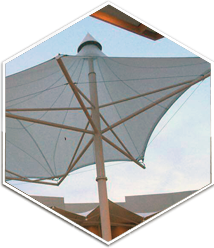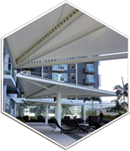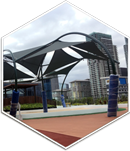A Tensioned Membrane Structure is most often used as a roof, as they can economically and attractively span large distances. With proper design, efficient engineering, fabrication and installation, end users can enjoy aesthetic free-form designs beyond imagination.
Steady technological progress has increased the popularity of fabric and membrane roofed structures. The low weight of the materials makes construction much more economical and easier than standard designs, especially when vast open spaces have to be covered.
It includes permanent and temporary structures. This standard will be valuable to engineers and practitioners involved in the construction and/or design of tensile membrane structures.
Tensile Materials
A special form of lightweight surface structures are fabric tensile structures (FTS) formed by continuous spatially curved surfaces elements. To resist environmental loads, uplift and down-forces, these surface elements are designed with sufficient curvature to ensure that the fabric remains in tension under all conditions. A coated structural fabric consists of a woven base cloth stabilized and protected by a coating on both sides. The base cloth consists of warp threads running the length of the roll and weft threads running across width. A mesh fabric is a coated cloth with spacing between the thread bundles. With some meshes for interiors use the threads are coated before weaving.
Common materials for doubly curved fabric structures are PVC (Poly Vinyl Chloride) coated polyester cloth and PTFE (Poly Tetra Fluro Ethlene) coated galss cloth. The PVC coating contains additives that include UV stabilizers, fire retardants, colouring and antifungicides. There is a choice of protective PVDF (Fluorinated Polmer) lacquers that enhance the cleanability of the pvc membrane. It will give lifespan of 10-15 years for the Weldable PVDF type. The French Fabric supplier Serge Ferrari will coat the fabric whilst keeping the warp and weft threads in tension known as the Precontraint method. This will result on more even stretch characteristics in both thread directions than a conventional coated fabric.


